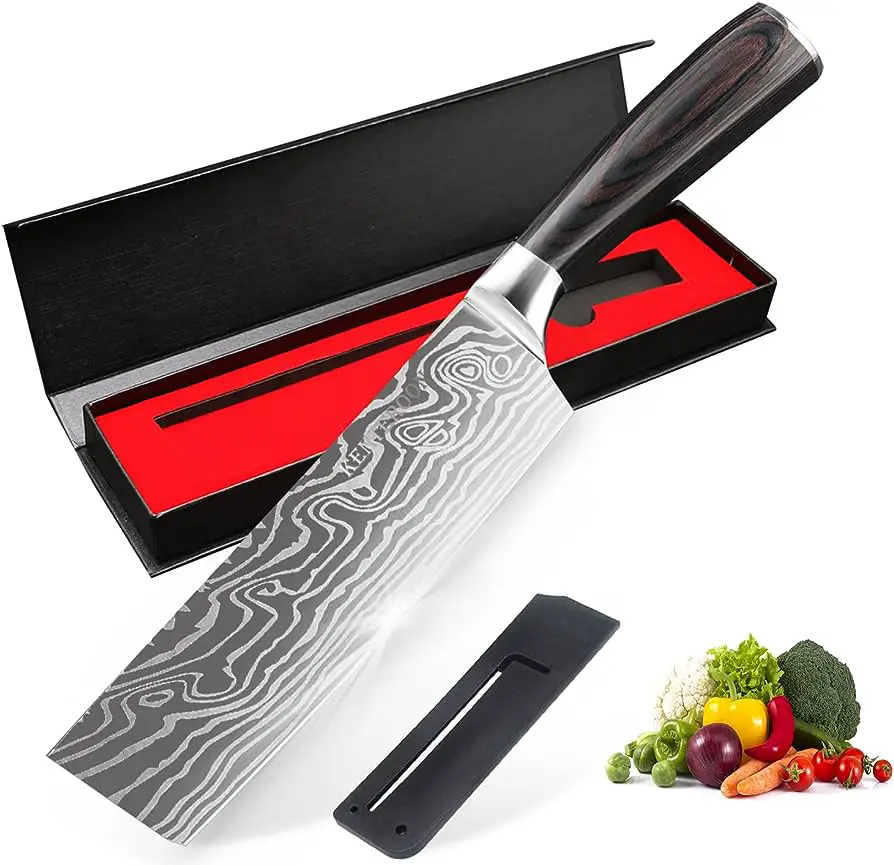Yes, you can use a Nakiri knife for meat, but it is more suitable for slicing and dicing vegetables due to its broad rectangular blade.
Introduction To Nakiri Knife
A Nakiri knife is a Japanese knife that is primarily designed for slicing and dicing vegetables. Its unique feature is its flat straight edge blade, which allows for precise cuts. While the Nakiri knife can be used on boneless cuts of meat and fish, its broad rectangular blade is not ideal for tougher cuts or butchering meat.
The flatness of the blade also enables you to cut all the way through to the cutting board without the rocking motion. This makes it perfect for achieving consistent and even slices. If you’re someone who enjoys cooking a lot of vegetables, then a Nakiri knife is a must-have tool in your kitchen.
Its versatility and precision will make vegetable preparation a breeze and elevate your culinary skills.
Nakiri Knife For Meat
The Nakiri knife is not ideal for cutting tougher cuts of meat or bone-in meat due to its thinner blade. However, it can be used for boneless cuts of meat and fish. The Nakiri knife’s broad, rectangular blade is particularly suited for slicing and dicing vegetables.
Its flatness allows you to cut all the way through to the cutting board without the need for a rocking motion. So, while the Nakiri knife is not specifically designed for meat, it can still be used effectively for certain types of meat cuts and is a versatile tool in the kitchen.
Factors Governing the Use of Nakiri for Meat
To gauge the Nakiri’s capabilities with meat, we need to scrutinize various factors:
Design and Functionality: At its core, the Nakiri is optimized for straightforward slicing, especially for vegetables. Meat, on the other hand, especially when bone-in, often requires a rocking motion, which the Nakiri’s flat edge isn’t inherently designed for.
Blade’s Sharpness and Maintenance: Meat cutting demands an impeccably sharp blade. While Nakiris can be razor-sharp, it’s vital to maintain this sharpness, particularly if meat becomes a regular adversary. Dull blades not only compromise the quality of cuts but can also be hazardous.
Nature of Meat: There’s meat, and then there’s meat. What this means is that while a Nakiri might gracefully handle thin boneless chicken or fish slices, it might falter with thicker steaks or tough mutton.
Weighing the Trade-offs
Using tools beyond their intended purpose often comes with compromises:
Versatility vs. Mastery: While versatility is a commendable trait, there’s undeniable merit in specialization. A jack-of-all-trades might handle various tasks decently, but mastery often lies in specificity. Using the Nakiri for meat might offer versatility, but at the potential cost of the precision and finesse specialized meat knives offer.
Maintenance and Longevity: Subjecting the Nakiri to regular meat cutting, especially tougher varieties, might necessitate frequent sharpening. Over time, this could wear down the blade quicker than if it were used primarily for vegetables.
Challenges in Straying from Convention
Performance Expectations: If you’re accustomed to the performance of specialized meat knives, the Nakiri might seem lacking. Achieving thin slices, deboning, or handling tough cuts might pose challenges.
Potential for Damage: Meat, with its fibrous texture and occasional bones, poses a risk of chipping or damaging the blade, especially if used with excessive force.
Alternative Uses Of Nakiri Knife
The Nakiri knife, typically known for its exceptional vegetable cutting abilities, can also be used for meat. While it may not be ideal for tougher cuts or bone-in meat, its flatness and thin blade make it suitable for boneless cuts of meat and fish.
The Nakiri knife’s squared-off spine and rounded tip allow for precise slicing and dicing techniques, making it a versatile tool in the kitchen. It is particularly suited for slicing and dicing vegetables, mincing herbs and garlic with precision. So, if you’re looking for a knife that can handle both your vegetable and meat prep needs, the Nakiri knife is definitely worth considering.
Its unique design and functionality make it a valuable addition to any kitchen arsenal.

Credit: www.wayfair.com
Expert Opinions on Using a Nakiri Knife for Meat
The Nakiri knife, with its rich Japanese heritage, has long been recognized for its exceptional performance with vegetables. Its unique design and sharpness make it a favorite for many chefs globally. However, its usage for meat has been a topic of debate among culinary professionals. Here’s a collection of expert opinions on the subject:
1. Chef Akira Hirose:
“The Nakiri knife has a precision that’s unmatched when it comes to vegetables. While it can handle boneless meats quite efficiently, for bone-in cuts or meats with a lot of sinew, I’d prefer to reach for a dedicated meat knife. But in a pinch? Sure, the Nakiri can hold its own.”
2. Culinary Instructor Melissa Raymond:
“Many of my students are often curious about using the Nakiri for meat. My advice? Understand the knife and its strengths. It’s fantastic for thin slices of meat, like in stir-frys or certain Asian dishes, but I wouldn’t recommend it as a primary meat knife.”
3. Master Butcher Liam O’Sullivan:
“In my line of work, precision and efficiency are crucial. While the Nakiri is a gem for vegetables, when it comes to meat, especially tougher cuts or deboning, it wouldn’t be my first choice. That said, for home cooks looking for versatility, it can certainly do the job with care.”
4. Chef and Cookbook Author Anika Patel:
“Culinary tools are about personal connection and understanding. I’ve seen chefs use a Nakiri beautifully with fish and even poultry. It’s all about knowing the knife, respecting its design, and adapting your technique.”
5. Knife Artisan Kazuki Yamamoto:
“The Nakiri’s design, from blade geometry to edge sharpness, is optimized for straight cuts, which is why it excels with vegetables. When you bring meat into the equation, especially varied cuts, the game changes. Can it work? Yes, especially with softer, boneless meats. But it’s essential to be cautious and avoid bones and tougher sections that might damage the blade.”
6. Culinary Historian Dr. Leticia Gomez:
“Throughout history, we see tools being adapted and used for various purposes. The Nakiri, while traditionally for vegetables, reflects this adaptability. Its use for meat isn’t traditional, but culinary art is as much about innovation as it is about tradition.”
Conclusion
The nakiri knife is a versatile tool that excels at slicing and dicing vegetables, thanks to its broad rectangular blade. While it can be used on boneless cuts of meat and fish, its flatness and thin blade make it less suitable for tougher cuts or butchering meat.
If you’re looking to cut through thick vegetables or meat, you may want to consider other knives better suited for those tasks. With its unique design, the nakiri knife’s flat, straight-edge blade and longer length make it ideal for cutting up all types of vegetables or mincing small pieces of garlic.
Vegetarians and vegans will appreciate its precision and ease of use in the kitchen. However, it’s important to note that the nakiri knife is not intended for slicing meat or splitting bones. Its true value lies in its ability to streamline vegetable preparation and enhance your culinary experience with vibrant and delicious plant-based dishes.
So, while the nakiri knife can be used for meat, it truly shines when it comes to vegetables and plant-based cooking. Invest in a nakiri knife if you want to elevate your vegetable preparation and create beautiful, flavorful dishes packed with nutrients.

This is Kristina, a passionate content writer, copywriter, and bookworm. Always dedicated to providing informative and accurate product reviews for enjoyable shopping. In my free time, I love spending time in nature and with animals and doing yoga.

